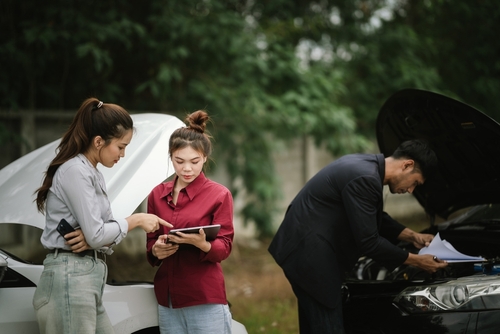
When Oklahoma Weather Turns Dangerous: Understanding Your Rights After a Weather-Related Crash
Winter ice coating Highway 169 near downtown Tulsa creates hazardous driving conditions that lead to thousands of accidents each year. If you’ve been injured in a weather-related crash, you might assume that bad weather makes these accidents unavoidable acts of nature where no one is at fault. However, Oklahoma law recognizes that drivers have a legal duty to adjust their driving to match weather conditions, and when they fail to do so, they can be held responsible for the resulting damages. Understanding how liability works in severe weather accidents can make the difference between accepting a denied insurance claim and recovering the compensation you deserve for your injuries, medical bills, and lost wages.
💡 Pro Tip: Document weather conditions immediately after your accident by taking photos and screenshots of weather reports. This evidence can prove crucial in establishing that another driver failed to adjust their speed or driving behavior appropriately.
When the weather takes a turn for the worse, navigating the aftermath of an auto accident shouldn’t add to your worries. Let Cain Law handle the legwork for you, ensuring you’re not left out in the cold with your claim. Reach out today at 855-759-7874 or contact us to set the wheels of justice in motion.
Your Legal Rights When Bad Weather Contributes to an Accident
Oklahoma law doesn’t give drivers a free pass just because weather conditions were poor when an accident occurred. The legal standard of reasonable care requires all drivers to adjust their behavior based on road conditions, which means slowing down in rain, increasing following distance on ice, and using headlights in fog. When a driver fails to make these adjustments and causes an accident, they can still be held liable for negligence. Working with an auto accident lawyer in Tulsa becomes particularly important in these cases because insurance companies often try to blame weather conditions entirely, hoping victims will accept that nobody was at fault.
Beyond driver negligence, weather-related accidents can involve other liable parties that many victims overlook. If your vehicle’s safety features failed to function properly during adverse weather—such as anti-lock brakes not engaging on wet roads or traction control systems malfunctioning—the vehicle manufacturer might bear responsibility. Additionally, government entities responsible for road maintenance could be liable if they failed to properly treat icy roads or provide adequate warning signs about dangerous conditions. Each potential source of liability requires different legal approaches and deadlines, making it essential to consult a lawyer who understands the complexities of weather-related accident claims.
💡 Pro Tip: Request a copy of the police report and pay special attention to any notes about weather conditions, road treatments, and whether the officer cited anyone for driving too fast for conditions—this violation can establish negligence even without a speeding ticket.
The Timeline: From Weather-Related Crash to Fair Compensation
The path to recovery after a weather-related accident follows a specific timeline that requires prompt action at each stage. Understanding these critical deadlines and milestones helps ensure you don’t miss important opportunities to strengthen your case. Many victims make the mistake of waiting to see if insurance companies will treat them fairly, only to discover months later that crucial evidence has been lost or legal deadlines have passed.
- First 24-48 hours: Seek medical attention even for minor injuries, as adrenaline can mask serious conditions. Document all weather conditions through photos, weather service reports, and road condition alerts issued by the Oklahoma Department of Transportation.
- Within 1 week: Notify your insurance company about the accident, but avoid giving recorded statements about fault. Insurance adjusters often use weather as an excuse to deny claims, so stick to basic facts about when and where the accident occurred.
- Days 7-30: Gather evidence including surveillance footage from nearby businesses (which is often deleted after 30 days), witness contact information, and vehicle maintenance records that might reveal safety system failures.
- Months 1-6: Complete medical treatment or reach maximum medical improvement. During this time, an auto accident lawyer in Tulsa can investigate whether road maintenance crews properly treated the area and if other accidents occurred at the same location.
- Within 2 years: File a lawsuit if necessary. Oklahoma’s statute of limitations gives you two years from the accident date to file a personal injury lawsuit, but claims against government entities for poor road maintenance may have much shorter deadlines—sometimes as little as one year.
💡 Pro Tip: Create a dedicated email folder and save all weather alerts, road condition warnings, and news reports from your accident date. These contemporaneous records often disappear from official websites but can prove invaluable in establishing dangerous conditions.
Fighting Back: How an Auto Accident Lawyer in Tulsa Levels the Playing Field
Insurance companies have teams of adjusters and lawyers ready to minimize or deny weather-related accident claims, often arguing that bad weather makes accidents unavoidable and therefore no one’s fault. This strategy saves insurance companies millions of dollars annually at the expense of injured victims. However, an experienced auto accident lawyer in Tulsa can counter these tactics by thoroughly investigating the accident, consulting with accident reconstruction specialists, and demonstrating how the at-fault driver’s actions—not just the weather—caused your injuries. Cain Law has built a reputation for holding negligent drivers accountable even in challenging weather-related cases, understanding that Oklahoma drivers have a responsibility to operate their vehicles safely regardless of conditions.
The resolution process often involves negotiating with multiple insurance companies, each trying to shift blame to weather conditions or other parties. Your attorney can coordinate these complex negotiations while you focus on recovery, ensuring that all potential sources of compensation are pursued. This might include claims against the at-fault driver’s insurance, your own underinsured motorist coverage, product liability claims against vehicle manufacturers, and even claims against government entities for inadequate road maintenance. The goal is to secure compensation that fully covers your medical expenses, lost wages, vehicle repairs, and pain and suffering, rather than accepting a quick settlement that leaves you bearing the financial burden of someone else’s negligence.
💡 Pro Tip: Keep a detailed journal of how your injuries affect your daily life, including activities you can’t perform and pain levels. Insurance companies often undervalue pain and suffering in weather-related accidents, but detailed documentation helps prove the real impact on your life.
Hidden Factors That Affect Weather-Related Accident Claims
Weather-related accidents often involve complex factors that go beyond simple driver error, and understanding these hidden elements can significantly strengthen your claim. Commercial weather data services can provide detailed information about conditions at the exact time and location of your accident, sometimes revealing that weather was even worse than official reports indicated. Additionally, many modern vehicles record data about speed, braking, and stability control activation in the moments before a crash, which can prove whether the other driver attempted to slow down or continued driving recklessly despite dangerous conditions.
Vehicle Technology Failures in Severe Weather
Modern vehicles come equipped with numerous safety systems designed to help drivers maintain control in adverse weather, including anti-lock brakes, electronic stability control, and traction management systems. When these systems fail during severe weather, they can actually make accidents worse by giving drivers false confidence or failing to engage when needed most. An auto accident lawyer in Tulsa can work with automotive engineers to investigate whether safety system failures contributed to your accident, potentially opening up claims against vehicle manufacturers or automotive parts suppliers. Recent cases have revealed that some vehicles’ safety systems perform poorly in extreme cold or when sensors become obstructed by ice and snow, creating dangerous situations that drivers cannot anticipate or prevent.
💡 Pro Tip: If your vehicle or the at-fault driver’s vehicle is less than 5 years old, request that it be preserved for downloading of the Event Data Recorder (black box) information before any repairs are made. This data can reveal crucial details about vehicle performance during the crash.
Common Injuries From Weather-Related Crashes and Their Long-Term Impact
Severe weather accidents often result in more serious injuries than typical fender-benders because vehicles lose control at higher speeds or collide with multiple cars in chain-reaction crashes. Ice and snow-related accidents frequently cause violent spinning or rolling motions that can lead to traumatic brain injuries, spinal cord damage, and complex orthopedic injuries requiring multiple surgeries. Understanding the full scope of these injuries and their long-term consequences is crucial for securing adequate compensation, as insurance companies often try to settle quickly before the true extent of injuries becomes apparent.
The Economic Reality of Weather-Related Accident Injuries
The financial impact of weather-related accidents extends far beyond immediate medical bills and vehicle repairs. Victims often face months of physical therapy, lost wages during recovery, and decreased earning capacity if injuries prevent them from returning to their previous work. When pursuing compensation, an auto accident lawyer in Tulsa will calculate not just current expenses but also future medical needs, ongoing therapy costs, and the lifetime impact of permanent injuries. Weather-related accidents can be particularly devastating because they often occur during morning or evening commutes when multiple vehicles are involved, potentially limiting available insurance coverage and making it essential to identify all possible sources of compensation.
💡 Pro Tip: Request copies of all medical bills and explanations of benefits from your health insurance company, even if they’re currently covering treatment. You’ll need these records to seek reimbursement and ensure future medical needs are included in any settlement.
Frequently Asked Questions
Common Concerns About Weather-Related Accident Claims
Many accident victims have similar questions about how severe weather affects their legal rights and options for compensation. Understanding these issues helps you make informed decisions about your case and avoid common mistakes that could harm your claim. These questions reflect the real concerns of Oklahoma drivers who find themselves injured through no fault of their own when weather conditions contribute to accidents.
💡 Pro Tip: Write down your questions as they occur to you throughout the claims process. Even seemingly minor concerns can reveal important legal issues that affect your case’s value.
Taking Action: Your Next Steps After a Weather-Related Crash
The decisions you make in the days and weeks following a weather-related accident can significantly impact your ability to recover fair compensation. Understanding the legal process helps you avoid common pitfalls and protect your rights while focusing on physical recovery. Knowledge is power when dealing with insurance companies that hope you’ll accept their first offer without understanding the true value of your claim.
💡 Pro Tip: Before accepting any settlement offer, consult a lawyer to ensure it covers all your damages, including future medical needs that might not be apparent immediately after the accident.
1. Can I still recover damages if the police report says bad weather caused the accident?
Yes, you can still recover damages even if the police report mentions bad weather as a factor. Police officers often note weather conditions as contributing factors, but this doesn’t absolve drivers of their duty to operate vehicles safely under those conditions. An experienced Tulsa OK auto accidents attorney can demonstrate that the at-fault driver failed to adjust their speed, following distance, or driving behavior appropriately for the weather, making them liable despite the challenging conditions.
2. What if the insurance company says nobody is at fault because of ice on the road?
Insurance companies frequently use weather conditions as an excuse to deny claims, but Oklahoma auto accident claims attorneys understand that ice doesn’t eliminate driver responsibility. Drivers must anticipate seasonal weather hazards and adjust their driving accordingly. If another driver was speeding, following too closely, or failed to maintain control of their vehicle on icy roads, they can still be held liable for resulting accidents.
3. How long do I have to file a claim for a weather-related accident in Oklahoma?
Oklahoma’s statute of limitations gives you two years from the date of the accident to file a personal injury lawsuit. However, if your claim involves government entities for poor road maintenance, you may have as little as one year to provide notice of your claim. Consulting with an auto accident compensation Tulsa attorney quickly ensures you don’t miss critical deadlines that could bar your recovery.
4. Should I give a recorded statement to the insurance company about weather conditions?
You should consult a lawyer before giving any recorded statement to insurance companies. Adjusters often ask leading questions designed to make you admit that weather was the sole cause of the accident, potentially damaging your claim. A Tulsa auto accident legal advice provider can help you understand what information you’re required to provide and how to protect your rights during the claims process.
5. What evidence is most important for proving fault in a weather-related accident?
Critical evidence includes weather reports, road treatment records, surveillance footage, witness statements, and vehicle data recorder information. Photos of the accident scene showing road conditions, skid marks, and vehicle positions are particularly valuable. An Oklahoma auto accident claims attorney can help preserve this evidence and obtain additional proof through legal channels that aren’t available to individual victims.
Work with a Trusted Auto Accidents Lawyer
When severe weather contributes to an auto accident, having knowledgeable legal representation becomes even more crucial. Insurance companies often exploit weather conditions to avoid paying fair compensation, leaving injured victims to struggle with medical bills and lost wages. A skilled attorney understands how to investigate these complex cases, prove liability despite challenging weather conditions, and ensure you receive the compensation you deserve. Don’t let insurance companies convince you that bad weather means nobody is responsible for your injuries—contact a trusted legal advocate who will fight for your rights and help you navigate the path to recovery.
When storms catch you by surprise, don’t let the aftermath of an auto accident cloud your judgement. Reach out to Cain Law to clear the path to compensation, and take the first step towards resolution. Call us at 855-759-7874 or contact us today, and let us guide you confidently through the storm.


